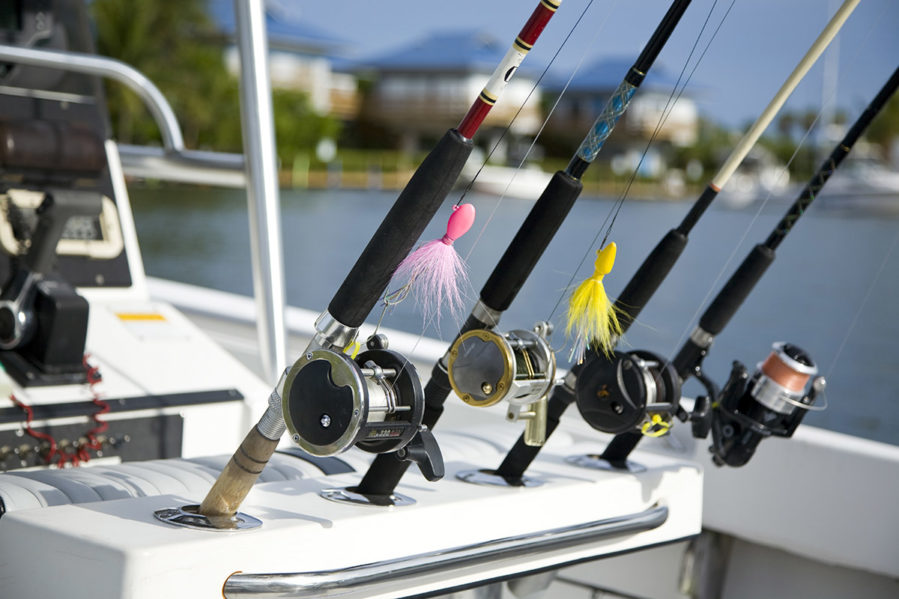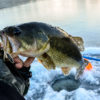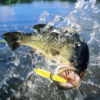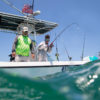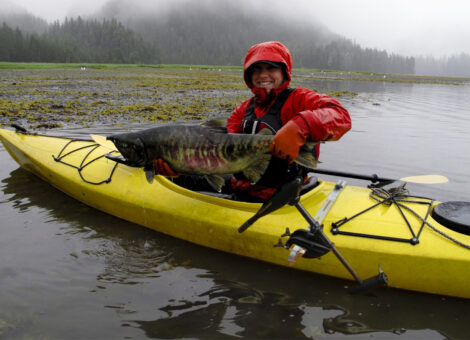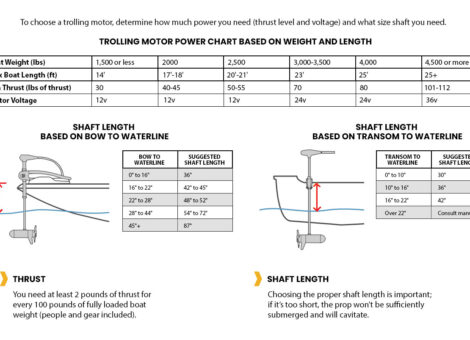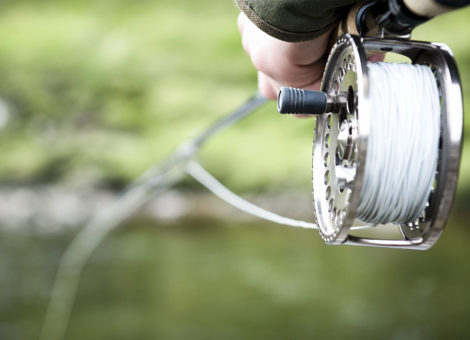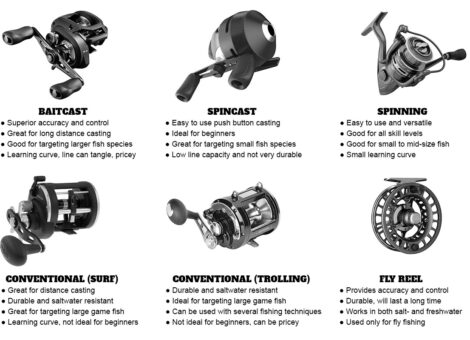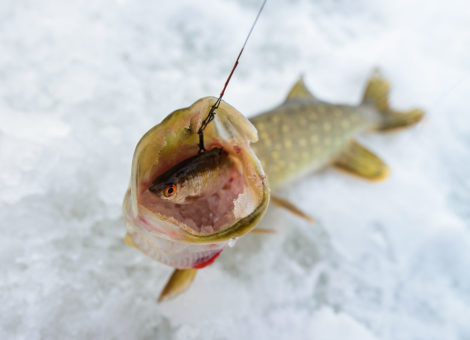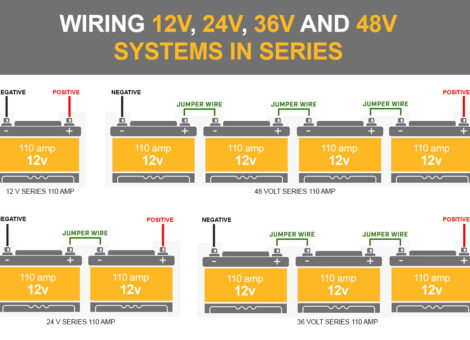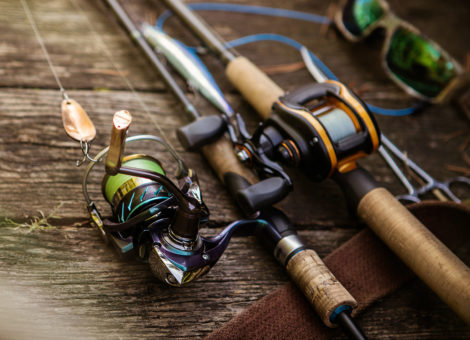One of the most important decisions you’ll make as a fisherman is which type of rod to buy. Many people don’t realize what a big difference a rod can make.The right rod can help you cast appropriately and work your bait more effectively. If you buy a rod without giving it much thought, you risk choosing something that hampers your efforts. By being selective and choosing the right rod, you can improve your chances of a successful fishing trip.
Venture into any large sports store and you’ll find hundreds of rods to choose from. It can be extremely overwhelming if you’re a beginner. With so many rods to choose from, where do you start? How do you decide which rod is right for you and your specific situation? There are many things to consider – length, materials, action and power. We’ll go over each of these in this article, and by the end, you’ll be able to make a solid choice.
What’s the optimal fishing rod length?
The first thing you’ll want to determine when looking for a rod is the proper length. Fishing rods can range anywhere from 4 to 14 feet long. How does the rod length factor into fishing? Don’t make the mistake of thinking that shorter people need shorter rods and vice versa. Height actually doesn’t have much to do with it. Instead, you want to choose the rod length that matches the type of fishing you’ll be doing. Each length has positives and negatives – that’s why you’ll need to really think about how you intend to use it.

A rod’s length determines how far you’re able to cast and how easy it is to maneuver. For example, a shorter rod is easy to control, but doesn’t allow you to cast your line out very far. And a longer rod is great for longer casting, but they can be really hard to handle.
In general, you want to choose a shorter rod if you plan on fishing close – like standing on the shore of a river. Short rods help you aim for that trout with pinpoint accuracy. They’re also more powerful and don’t bend or stretch as much when you’re fighting a big fish. And if you plan on fishing somewhere that has space constraints, like from a kayak, the advantage of a shorter rod is obvious.
Now, if you’re planning to fish in a big body of water, like the ocean, and will need to cast out pretty far, you’ll want to think about getting a longer rod. You’ll see a lot of people using longer rods for deep sea fishing or when casting from piers.
You may be thinking that you’d only need to use an 8+ foot rod if you’re fishing in the middle of the ocean, but this isn’t the case. Even though they can be a bit cumbersome, these larger rods also come in handy when fishing in a large freshwater lake and need to cast out really far. They’re a popular choice for people who like to fish for bass in large lakes and need to cover a lot of water in a short timeframe.
But what if you’re a beginner and you don’t really know what type of fishing you’ll be doing? In that case, your best bet is to choose a 7’ fishing pole. These are a good middle-of-the-road choice that work for pretty much any type of fishing you may be doing.
Which rod material is best?

Now that you’ve figured out the length of rod you need, it’s time to look at the material. When looking at fishing rods, you’ll notice they come in three main materials: graphite, fiberglass, or a combination of the two, known as composite. Just as with length, the material will make a difference, so choose wisely.
Fiberglass Rods
If you owned a fishing rod as a kid, it was probably made of fiberglass. This material has been used for many years and is very popular because it is both durable and inexpensive. For this reason, they’re a great choice for anyone just starting out.
Fiberglass rods do have some negatives though. Because they’re so strong, they can also be heavy. Their weight can make them hard to hold for long periods of time and difficult to handle during long fights with a strong fish. They also aren’t very sensitive, so you can’t immediately tell when you have a bite. This could mean missing out on a fish or two because you may miss the chance to sink the hook.
Still, despite their problems, they’re the best choice for beginners because they’re fairly easy to maintain and they won’t break the bank.
Graphite Rods
If you want the lightest rod available, consider selecting a rod made of graphite. Seasoned fishermen prefer graphite rods because they offer good fighting power. They’re also more rigid than fiberglass rods, making it easier to tell when you have a bite and less likely that the fish will get away. Just note that graphite isn’t as strong as fiberglass, so they break more easily. They also tend to be the most expensive rods, so they aren’t the best choice for those on a tight budget.
When deciding on a graphite rod, note that they’ll have markers on them as follows: IM6, IM7 and IM8. IM stands for Intermediate Modulus, which refers to the amount of graphite used in the rod. The higher the IM number, the more graphite it has.
How does the amount of graphite affect a rod? More graphite means it will be lighter. For example, an IM6 rod will be a little heavier than an IM8 rod. And as the rod uses more graphite and gets lighter, it also gets more expensive. So, you’ll be shelling out more money for that IM8 rod.
Composite Rods
If you’re looking for something with the best versatility, choose a composite rod. By combining graphite with fiberglass, they offer the best of both worlds. Composite rods are great because they are both flexible and lightweight. They’re also sensitive, so you’ll still be able to feel when you have a bite.
If you’re someone who likes to fish in many different locations and want a rod that can handle anything, this is your best choice. Because they combine both materials, they are the most versatile fishing rod you can find. As far as cost, they tend to fall somewhere between a fiberglass and a graphite rod.
Action
Now that you have narrowed it down to a certain length and material, let’s talk about action. What is action? It’s how much and where your rod will bend. This is determined by the rod’s shape and material. Action can be fast, medium or slow. Note that some manufacturers refer to action as light, medium or heavy. Regardless of which terminology is used, action is a key component in how your rod will perform.
Action will determine how you’ll handle your rod and what type of fish you can catch with it. Let’s go over the three main actions and how they can affect your fishing.
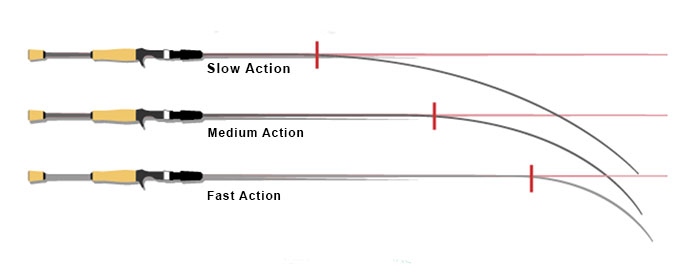
Fast (Heavy) Action
The main benefit of the fast action rod is its sensitivity. Bending right below the tip, these rods sense the tiniest bite and can snap back very fast. This allows you to immediately respond and makes them perfect for quickly setting a hook.
A fast action rod can be helpful in a variety of situations. First, they work great with single hooks, jigs and worms. They’re also the perfect rod to use with larger, heavier baits. Lastly, they have very strong backbones, which makes them great for getting fish out of heavy cover situations. This added strength also comes in handy when you’re trying to catch larger fish, like muskie in freshwater or tuna in saltwater. In other words, this is the action to choose if you’re looking to catch something you can mount on your wall.
Medium Action
Instead of bending at the tip of the rod like fast action rods, medium action rods bend at the top half, near the middle. This difference makes them a bit slower than a fast action rod, but still gives you the ability to quickly set the hook. They also let you cast out pretty far, depending on their length.
While you can use single hooks with medium action rods, they also work great for times when you want to use multiple hooks. Since medium action rods fall in between fast and slow action rods, they give you the most versatility. These rods offer both sensitivity and the ability to cast longer distances. You can use them to catch many different kinds of fish in various fishing locations.
Slow (Light) Action
Lastly, you have slow action rods, which bends all the way to the butt of the rod. The flexibility in these rods allows you to cast out really far. And once you catch a fish, their deep bending action makes fighting the fish a fun experience – especially really large, active fish like tuna.
Since you can cast far with these rods, you’ll want to pay special attention to which lure you’re using. For this rod, you’ll want to pick something on the smaller side because it doesn’t set the hook as quickly as the other rods. By choosing a smaller lure, there’s a better chance it will make its way into the fish’s mouth, giving you the chance to set it. Choose a lure that is fast-moving, like a spinner, or especially sharp like a treble hook.
Slow action rods can make setting the hook a bit tougher than other action rods. The deep bend means you’ll have to pull back further to get the hook to really sink in. But, on the positive side, once your fish is hooked, these rods make the job of reeling it in much easier.
Rod Power
The next thing to consider is a rod’s power. This refers to how much pressure you’ll have to put on the rod to get it to bend. Power also refers to the strength of the rod or how much weight it can lift. The various levels of power start at ultralight and go all the way up to ultraheavy. The heavier the rod, the more powerful it is. So, if you’re going for the big, trophy fish, choose the most powerful rod you can find. And if you’re planning on fishing for smaller fish in a lake, a less powerful rod will do the job just fine.
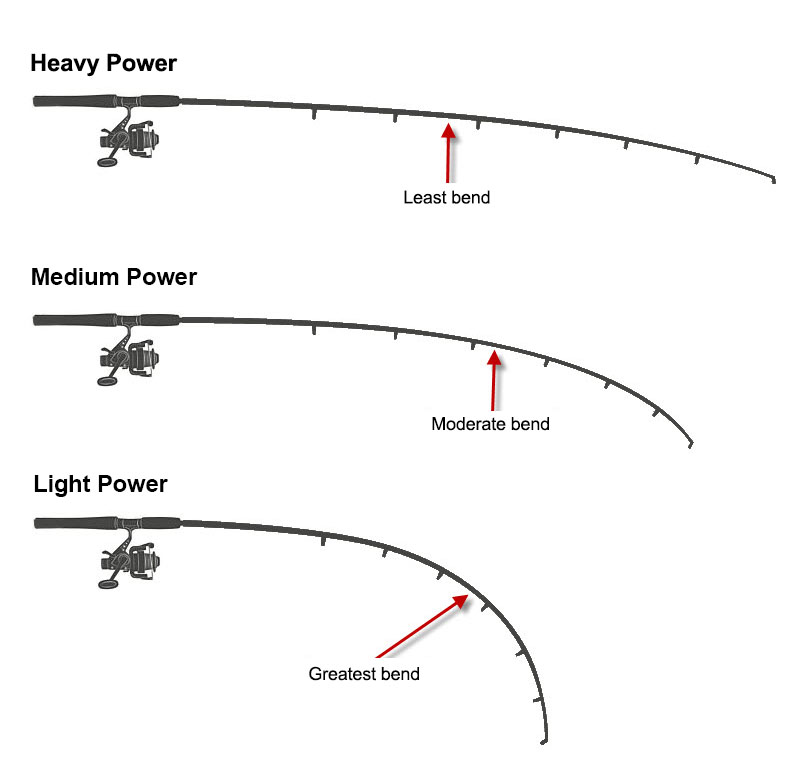
A rod’s power is closely related to the heaviness of the line it can handle. Therefore, you need to consider which type of line you’ll be using when deciding on the appropriate power. Ideally, you should match the strength of the line to the power of the rod. For example, if you’re working with heavier line, use a more powerful rod. If you try to use a light line with a heavy rod, you might snap the line. Conversely, if you’re using a light line, you want to use a lighter rod. If you use a heavy line with a light rod, you could snap the rod. This is why it’s important to check your rod to see what type of line its rated to handle.
Rod Markings
All of this information is well and good, but how do you tell a rod’s material, action and power just by looking at it? There’s a trick to help you quickly pick up a rod and know everything about it – look at the markings. By reading the markings, you can quickly figure out exactly what the rod offers so you can rule out those that don’t meet your requirements.
Let’s dissect these markings. Start with the first three numbers and letters. These generally have to do with the rod’s length. The next set of numbers tell you the action type. Next, you’ll see the information about the line and lure weights. A normal rod marking will look like this:
This is telling you that the rod is a 6-foot, 6-inch, medium light rod. It’s rated for 4 to10lb line and works best with 1/8- to 5/8-ounce lures.
Note that while this is the sequence you’ll see on most rods, some of them don’t use this same system. And some won’t have any markings at all. So, if you pick up a rod and don’t understand the markings, or can’t find them, you can always ask a sales associate.
Other Important Parts of a Fishing Rod
If you’ve come this far, you’ve probably narrowed it down to a few rods that have the same length, material, action and power. Now, you just have to consider a few other minor details to determine which one is the right rod for you.
Rod Guides (Rings)
Rod guides are those circular pieces of metal you see at various points along the length of the rod that hold the fishing line in place. They may seem pretty basic, but there are some things to consider.
Upon first glance, these guides appear to be made of solid metal. However, the center of them is usually coated with ceramic, which helps the line slide easily through them. Make sure you take a close look to ensure they have the ceramic coating. If they don’t, you should probably choose a different rod.
You also want to count the guides to see how many it contains. In general, the more guides it has, the better it is. Why is that? Because the guides help evenly distribute the weight of the line, giving you the ability to cast more precisely. Just note that more guides usually means a steeper price – though if you have the money, it’s well worth it.
Rod Handle
The rod handle is hugely important because you’ll be holding it the most. It’s also the item on this list that is the most subjective. Different people prefer different handles. Here are some things to consider if you aren’t sure which one suits you best.
Material
Most handles are made of either EVA foam or cork. Cork handles are generally more comfortable to use and more sensitive than the foam variety. That said, they’re also the more expensive option. Plus, they tend to break down a lot faster and can be harder to clean. And if you keep your rods in a holder, the cork is more likely to dent than foam.
So, if you’re someone who doesn’t like to spend a lot of time taking care of your equipment and you like things that are durable, you’ll want to opt for foam. However, if you’re more concerned about comfort, choose cork.
There are other options out there, many of which are made of composite materials. For those with deep pockets, there’s carbon fiber. This type of material is a great option if you want something that is both durable and comfortable, but it will cost you.
Shape
Just like hands, rod handles come in various shapes and sizes. But for the purpose of this article, we’ll stick to the main two: trigger stick and pistol grip.
The trigger stick has a long handle that allows you to use both hands. This can come in handy when casting out really far, or when battling a big fish. The pistol grip, on the other hand, is shorter and has a hook for your index finger, as the name suggests. This type of grip works best when you’re casting closer to shore and need to get your bait into a precise location.
As for which one is better overall, that’s a matter of personal preference and fishing styles. The good news is that they’re both at about the same price point, so you can choose whichever works best for you.
Freshwater vs Saltwater Rods
At first glance, there isn’t much difference between freshwater and saltwater rods. They generally look very similar and offer the same options. The main difference is in the materials. Saltwater rods have components made of corrosion-resistant materials. These can include carbon, stainless steel and titanium – most often used in the guides and reels.
Freshwater rods don’t usually have these additional materials in their components since the water in lakes, rivers and streams doesn’t have the corrosive salt that you find in the oceans.
So, do you really need to use a different rod for freshwater fishing than you use for saltwater fishing? Not necessarily. You could use one rod for both, just be aware that if you buy a freshwater rod and use it frequently for saltwater fishing, it will break down much faster. If you can only afford one rod, it’s best to base your purchase on the type of fishing you expect to do the most.
Types of Fishing Rods by Use
When it comes time to buy a fishing rod, you’ll have many different types to choose from – each with its own purpose. They’ll generally be divided into the following categories: spinning, baitcasting, surf, telescopic, overhead and fly. Let’s go over these in detail so you can determine which one will work best for the type of fishing you want to pursue.
1. Spinning rods
Your standard fishing rod is a spinning rod. This is the one you’ll see most often and is a good choice for beginners.
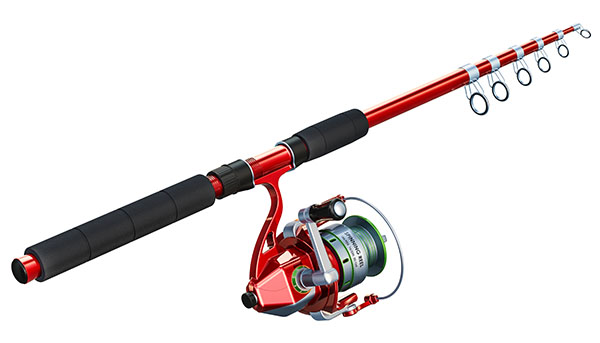
This type of rod has a spinning wheel mounted on the underside. Most often used for bait fishing and lure casting, the rod and reel setup on spinning rods make them very versatile. They’re especially good for people who like to fish from the shore for small- to medium-sized fish. They also work well when fishing from a boat or kayak.
2. Baitcasting rods
The next most popular type is the baitcasting rod.
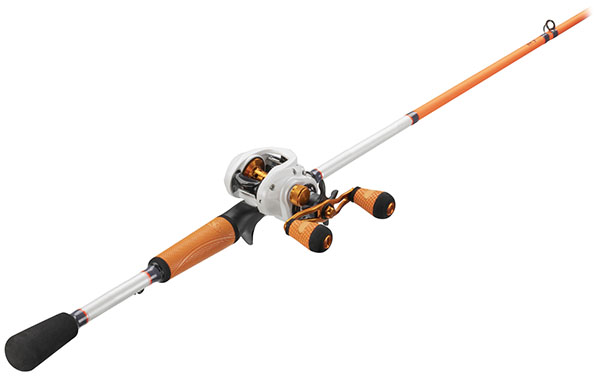
Like the spinning rod, they’re very versatile. But unlike the spinning rod, they’re not the best choice for beginners. This is because they are prone to the dreaded “bird’s nest” if not handled properly. A “bird’s nest” is a huge tangle of line that is virtually impossible to untangle. Baitcasting rods require a steady, precise hand to maneuver the casting equipment. For this reason, they tend to scare away amateurs. However, they’re often preferred by the seasoned fisherman because they give you better control and allow you to cast more accurately.
3. Surf rods
For those who enjoy fishing in the surf, there’s the aptly named surf rod. These rods also work well for fishing off rocks. Ranging from 9 to 14 feet long, surf rods are the longest rods you’ll find. While the length is somewhat cumbersome, it comes in handy when you need to cast for long distances to get to the fish hiding out past the breakers.
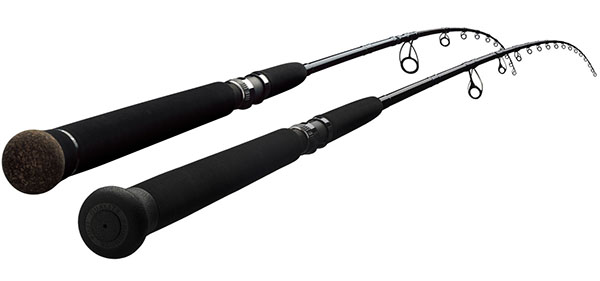
These rods are usually fitted with a large spinning reel and have a longer handle that allows you to cast with two hands. Surf rods are especially strong and are made to support the weight of a large fish and the accompanying waves you’re trying to pull it through. And though these rods are long, they’re designed to be taken apart so they can be easily transported.
4. Telescopic rods
The telescopic rod is a great choice for people who love to fish but don’t want the burden of carrying a long rod around. They’re especially great for hikers because you can fit them into your backpack and pull them out when you run across a stream or lake. They also work well for people who love to travel but don’t have the space to tote a large fishing rod around in their car. Telescopic rods are generally designed to be used with a spinning real. And don’t worry about quality – they’ve come a long way over the years. Gone are the days of cheap and flimsy telescopic rods. Today you can find some quality options out there made to handle small to medium fish.
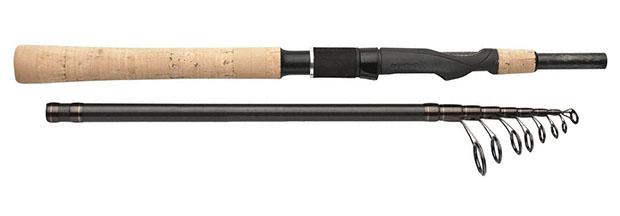
5. Overhead rods
When it comes to boat fishing in the sea or in a very large lake, you’ll most likely want to get yourself an overhead rod. Designed to be used with an overhead reel, these shorter, more powerful rods are the best choice to use when you plan to be reeling in a really big fish. These rods can handle sportfish and deep-sea fish, such as redfin and stripers. And you don’t need to worry about getting the perfect cast with overhead rods – simply drop your line into the ocean and wait for that big bite.

6. Fly rods
Fly fishing is much different than regular fishing, which is why it requires a specially designed rod. Using a fly reel, these rods make it easier to cast your fly out in a way that makes it look real to the fish. Note that it takes a lot of skill, patience and practice to get good at fly fishing – it’s not something just anyone can go out and do the first time with ease.
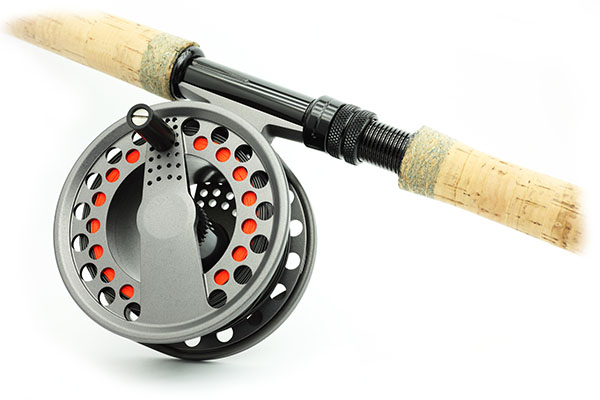
Fly rods are designed for the activity most often associated with fly fishing – catching trout in freshwater streams and lakes. However, you can also use fly rods with various types of reels to catch different types of fish, such as bass. If you’re a beginner who is interested in learning more about fly fishing, check out our handy guide for some great tips.
7. Trolling Rods
Trolling rods are typically more durable and heavy-duty than other types of fishing rods. They are made for use on boats and for catching larger species of fish, such as tuna, marlin or lake trout. Trolling rods are mounted in a holder that is attached to the boat, which moves through the water with the fishing line and lure in tow.
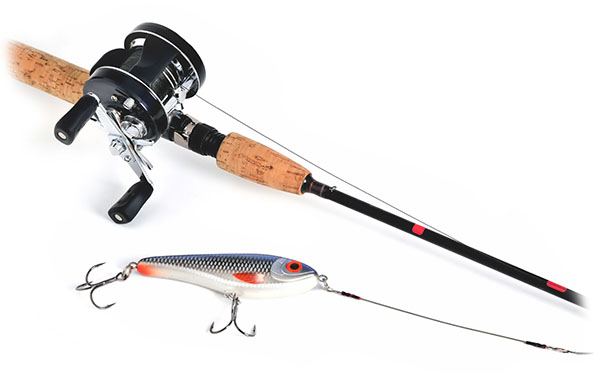
The dragging motion of the boat causes the lure to “swim” and catch the attention of feeding fish. Trolling rods are not as widely used as other types of poles, but they’re very popular among anglers that do a lot of boat fishing in larger lakes or oceans.
8. Ice Fishing Rods
Ice fishing rods are similar to spinning rods, but they’re much smaller. An average fishing rod only measures two to three feet from grip to tip. Ice fishing rods are designed specifically for ice fishing. Due to their small size, they don’t cast well. They do however fit into confined spaces (such as an ice fishing shelter), are ideal for lowering bait through a small hole in the ice, and are very sensitive to any motion on the line.
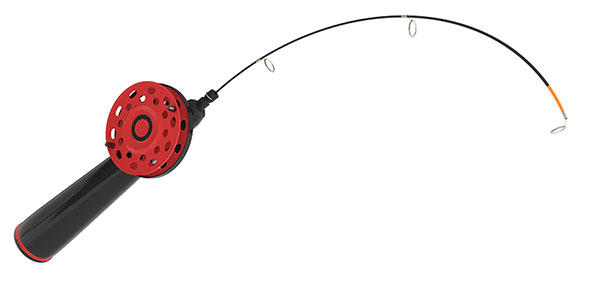
Ice fishing rods are intended for catching small to medium fish, such as perch, crappie, trout, walleye and pike. Anything larger could cause the rod to snap. Compared to other types of rods, ice fishing rods are fairly inexpensive. As there is no casting involved with using a fishing rod, they super easy to use and ideal for young or novice anglers.
9. Kids rods
Choosing a rod for your child can be a fun adventure in itself. Ideally, you should bring your child along so you can help them pick one that they can easily handle. You’ll want to pick something that isn’t too big, otherwise they could get frustrated and decide they don’t like fishing.
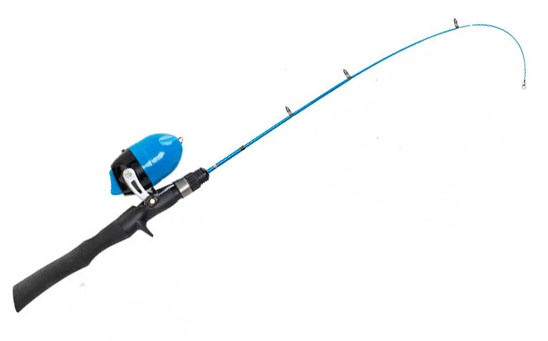
When choosing a child’s rod, you want to consider the type of fishing you’ll be doing, but you also want to make sure the rod will be easy for them to use. Look for a standard setup, such as a light spinning rod and reel. These are easy for kids to control. Plus, your child will probably outgrow the rod at some point, so you may not want to spend too much money on something fancy.
Use this infographic as a quick reference guide to help you understand all the elements of a fishing rod. It helps explain where and when to use the various rods and the best reels to accompany them.


